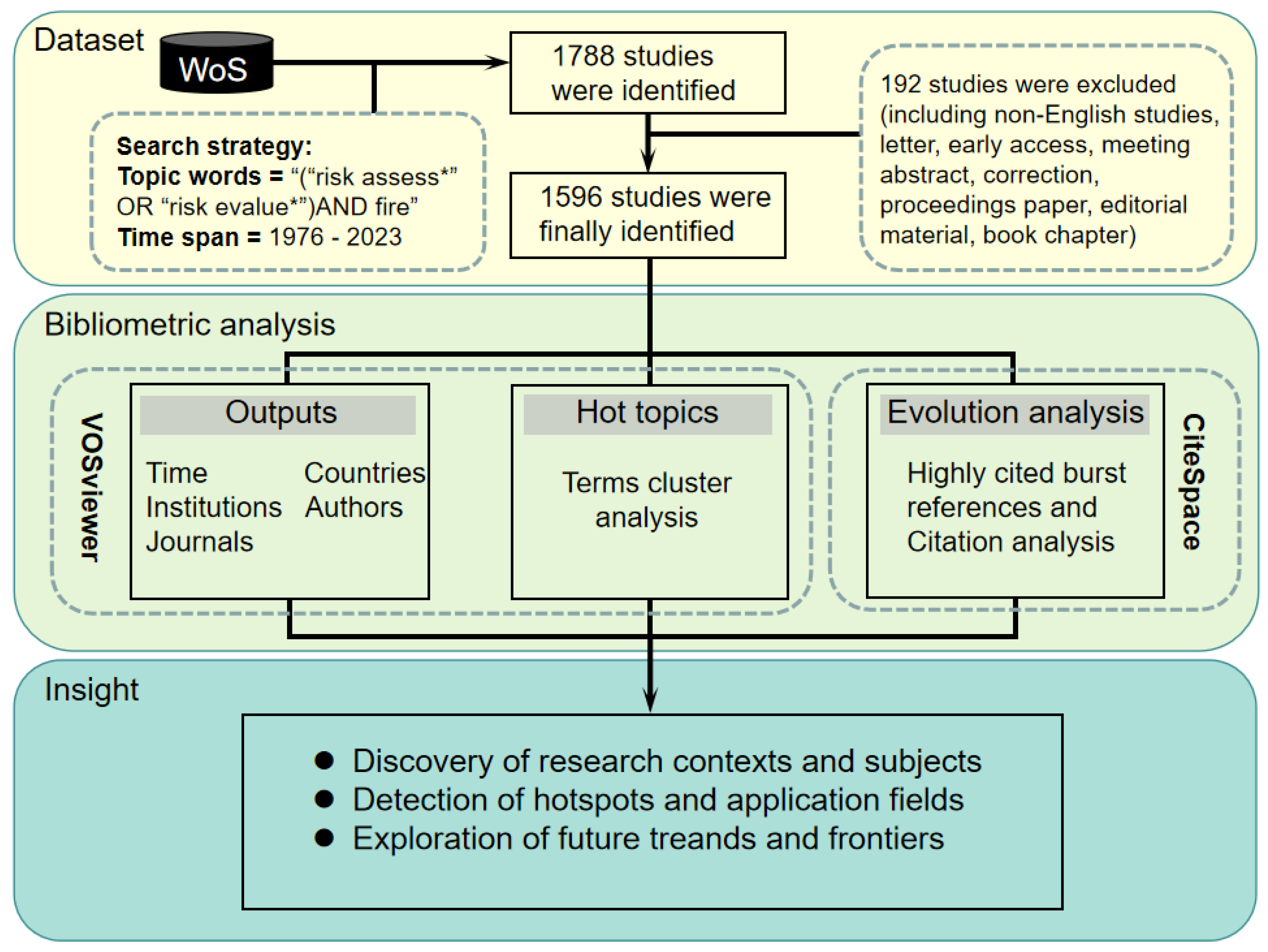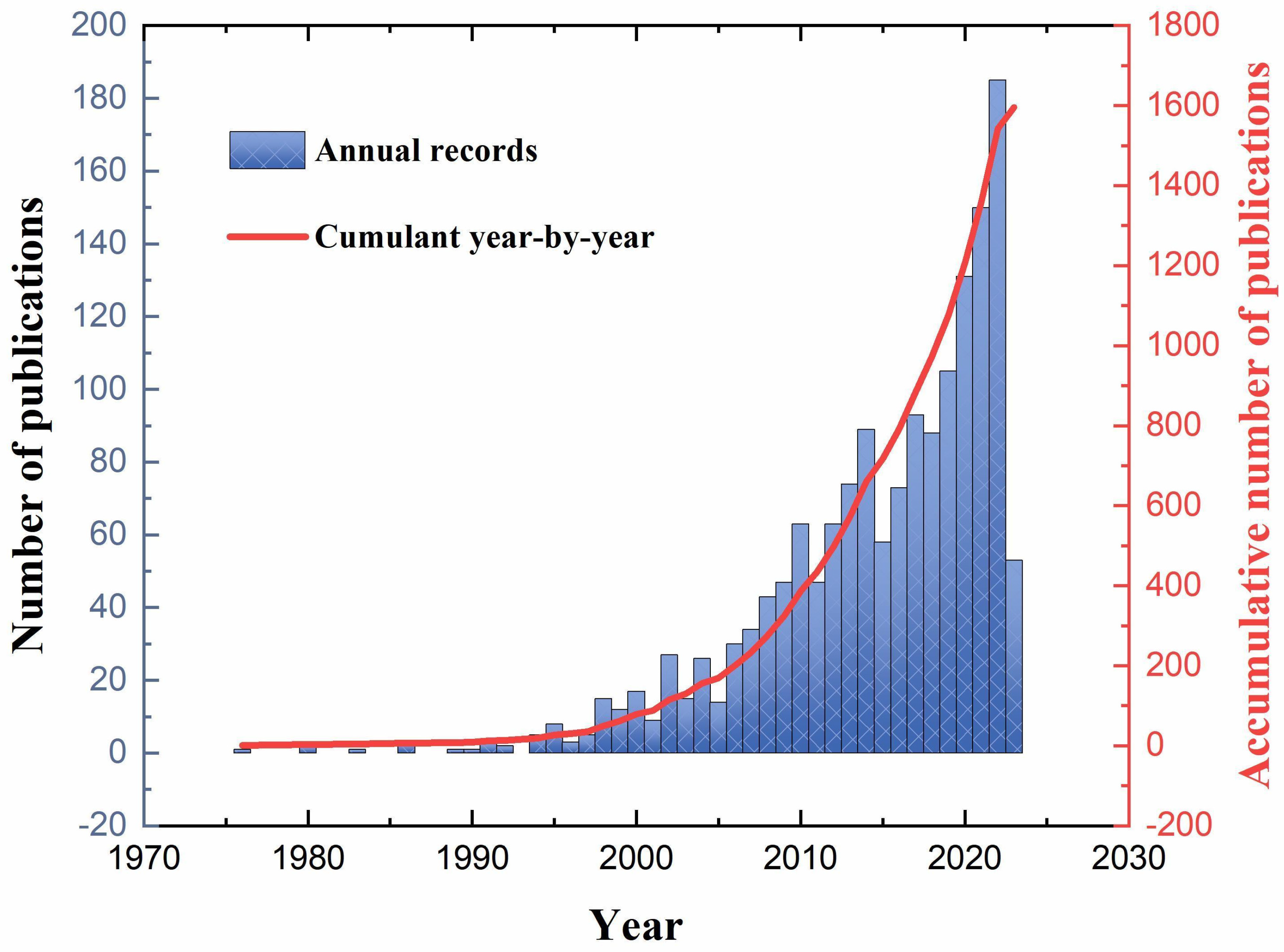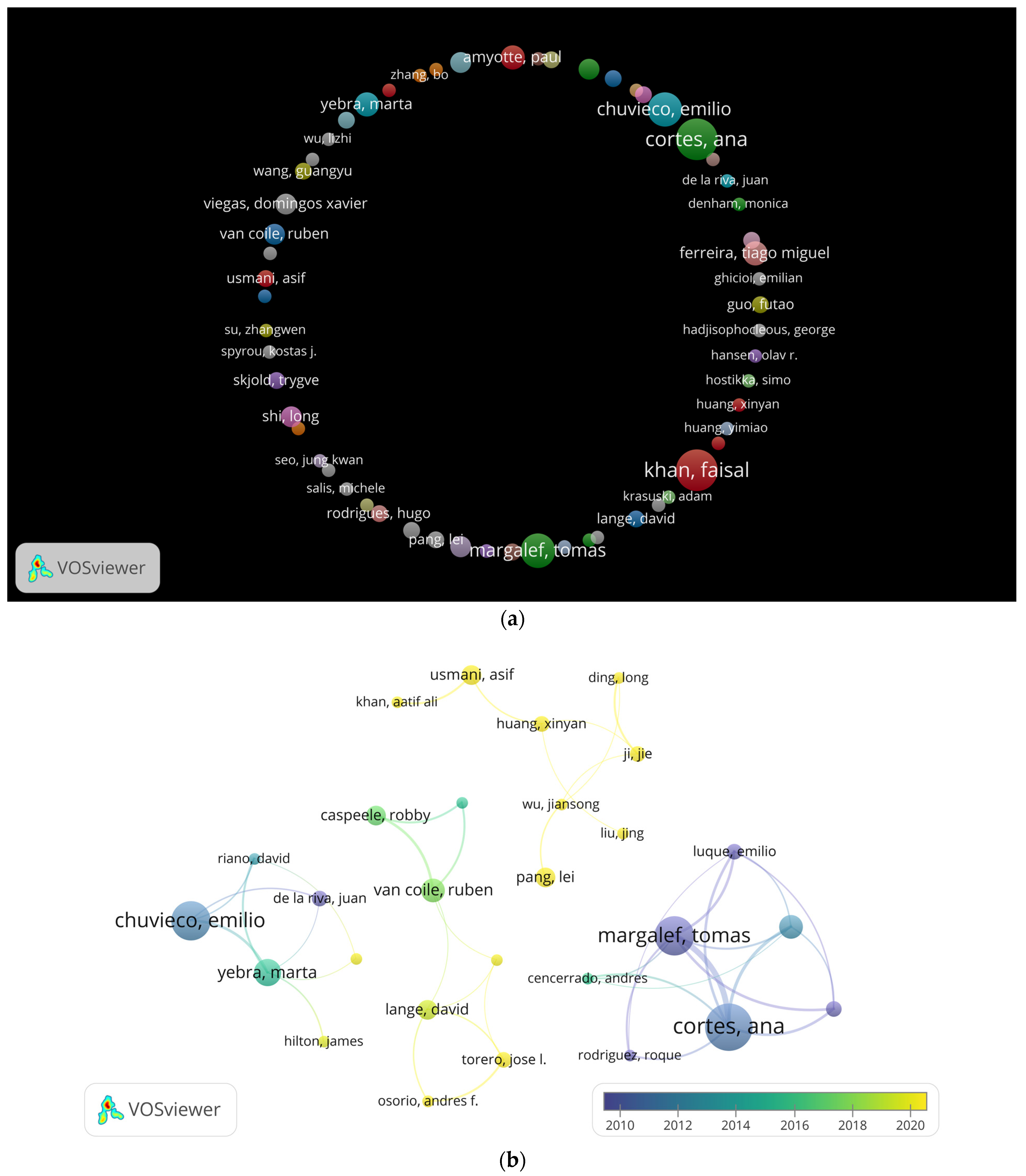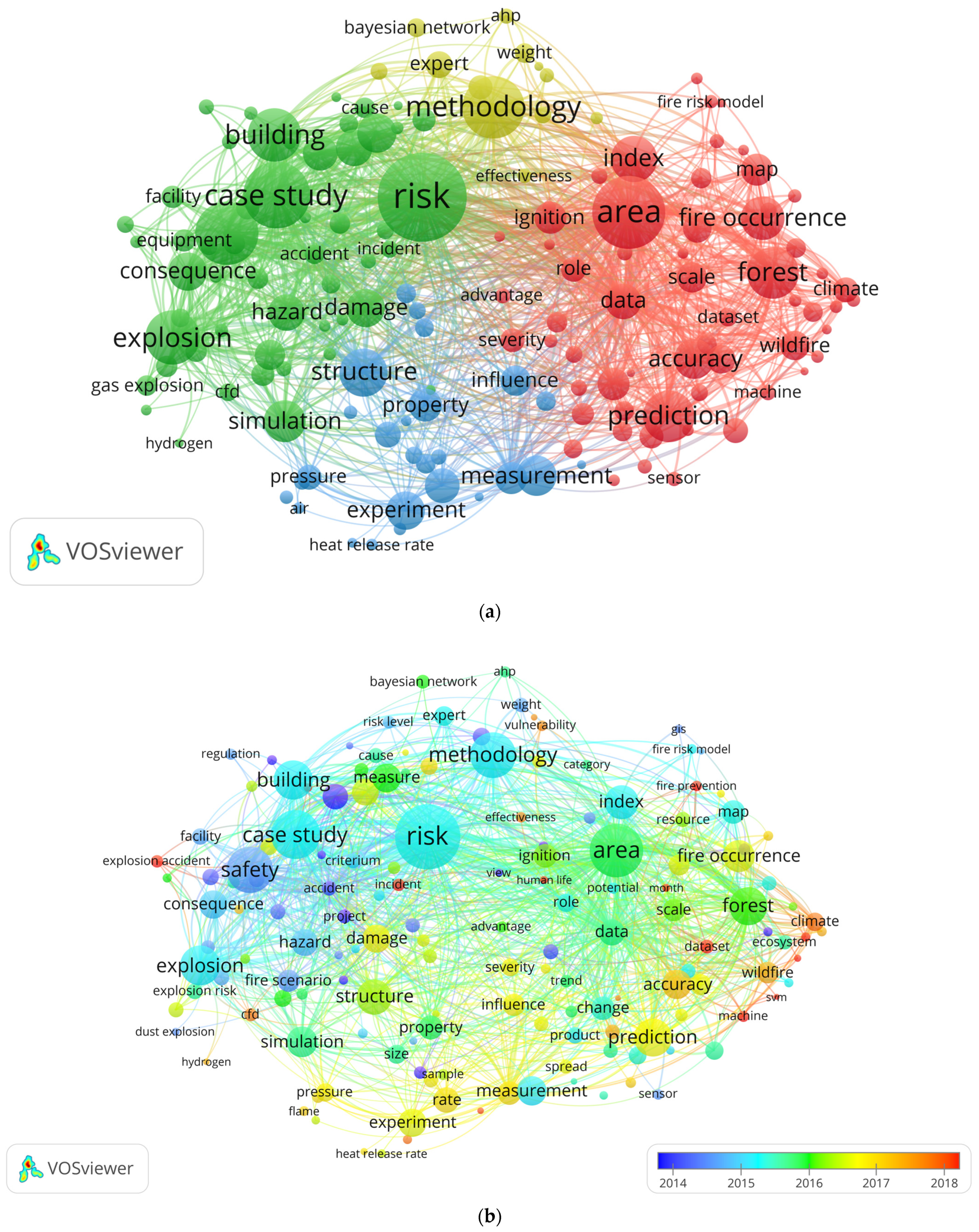Knowledge Mapping for Fire Risk Assessment: A Scientometric Analysis Based on VOSviewer and CiteSpace
Abstract
1. Introduction
2. Data and Methods
2.1. Data Source
2.2. Methods
3. Results and Discussion
3.1. Research Status
3.1.1. Analysis of Publication Outputs
3.1.2. Analysis of Countries
3.1.3. Analysis of Institutions
3.1.4. Analysis of Authors
3.1.5. Analysis of Journals
3.2. Research Hotspots and Frontiers
3.2.1. Analysis of Terms
3.2.2. Analysis of Highly Cited Burst References
4. Conclusions
- (1)
- In terms of temporal development, the publication volume can be divided into three phases: the nascent period (1976–1993), the stable exploration period (1994–2005), and the rapid development period (2006–2023). Overall, there has been a continuous upward trend, reflecting the significance and ongoing attention of the academic community towards the field of fire risk assessment. In regard to spatial distribution, China and the United States hold dominant positions in driving the development of fire risk assessment, and they have established collaborative relationships with other countries. Additionally, India and Australia are emerging forces that have the potential to contribute to the advancement of research in this field.
- (2)
- The University of Science and Technology of China, the US Forest Service, and the China University of Mining and Service are the key players among research institutions in the field of fire risk assessment. There are several expert research groups in this field, with collaboration primarily occurring within institutions and limited cross-institutional cooperation. Furthermore, these research groups have different areas of focus. Journals in this field can be classified into three categories: engineering safety journals, fire safety journals, and forest fire prevention and control journals. The research findings exhibit a multidisciplinary approach, and the articles generally maintain a high quality and carry influence in various disciplinary domains.
- (3)
- The cluster analysis of subject terms reveals that the main research directions in the field of fire risk assessment at this stage are typical fire site risk, fire risk assessment methodology, forest fire and area fire assessment and prediction, and fire experiments and testing. The research hotspots primarily revolve around investigating fire and explosion accidents, assessing the vulnerability of fire subjects, and identifying potential fire hazards. The application of artificial intelligence technology is identified as a pivotal tool for future development. The analysis of highly cited outbreak literature highlights the significance of Westerling, A.L. (2006), Chuvieco, E. (2010), Martinez, J. (2009), Giglio, L. (2016), Giglio, L. (2018), and Guo, F.T. (2016) as important contributions to this field. It is recommended that scholars who are new to this field read these articles, which will greatly contribute to a rapid understanding of the field of fire risk assessment.
Author Contributions
Funding
Institutional Review Board Statement
Informed Consent Statement
Data Availability Statement
Conflicts of Interest
References
- Bowman, D.M.J.S.; Balch, J.K.; Artaxo, P.; Bond, W.J.; Carlson, J.M.; Cochrane, M.A.; D’Antonio, C.M.; DeFries, R.S.; Doyle, J.C.; Harrison, S.P.; et al. Fire in the Earth system. Science 2009, 324, 481–484. [Google Scholar] [CrossRef]
- Van Oldenborgh, G.J.; Krikken, F.; Lewis, S.; Leach, N.J.; Lehner, F.; Saunders, K.R.; van Weele, M.; Haustein, K.; Li, S.; Wallom, D.; et al. Attribution of the Australian bushfire risk to anthropogenic climate change. Nat. Hazards Earth Syst. Sci. 2021, 21, 941–960. [Google Scholar] [CrossRef]
- Fares, M.Y.; Musharrafieh, U.; Bizri, A.R. The impact of the Beirut blast on the COVID-19 situation in Lebanon. J. Public Health 2023, 31, 575–581. [Google Scholar] [CrossRef]
- Hassan, M.M.; Hassan, I.; Southworth, J.; Loboda, T. Mapping fire-impacted refugee camps using the integration of field data and remote sensing approaches. Int. J. Appl. Earth Obs. Geoinf. 2022, 115, 103120. [Google Scholar] [CrossRef]
- Kong, B.; Li, Z.; Yang, Y.; Liu, Z.; Yan, D. A review on the mechanism, risk evaluation, and prevention of coal spontaneous combustion in China. Environ. Sci. Pollut. Res. 2017, 24, 23453–23470. [Google Scholar] [CrossRef] [PubMed]
- Ntzeremes, P.; Kirytopoulos, K. Evaluating the role of risk assessment for road tunnel fire safety: A comparative review within the EU. J. Traffic Transp. Eng. Engl. Ed. 2019, 6, 282–296. [Google Scholar] [CrossRef]
- Thompson, M.P.; Calkin, D.E. Uncertainty and risk in wildland fire management: A review. J. Environ. Manag. 2011, 92, 1895–1909. [Google Scholar] [CrossRef] [PubMed]
- Park, Y.J.; Kim, M.K.; Kim, H.S.; Lee, B.M. Risk assessment of lithium-ion battery explosion: Chemical leakages. J. Toxicol. Environ. Health Part B 2018, 21, 370–381. [Google Scholar] [CrossRef] [PubMed]
- Pacifico, L.R.; Pizzolante, A.; Guarino, A.; Iannone, A.; Esposito, M.; Albanese, S. Wildfires as a Source of Potentially Toxic Elements (PTEs) in Soil: A Case Study from Campania Region (Italy). Int. J. Environ. Res. Public Health 2023, 20, 4513. [Google Scholar] [CrossRef]
- Alexakis, D.E. Suburban areas in flames: Dispersion of potentially toxic elements from burned vegetation and buildings. Environ. Res. 2020, 183, 109153. [Google Scholar] [CrossRef]
- Liu, J.; Li, J.; Wang, J. In-depth analysis on thermal hazards related research trends about lithium-ion batteries: A bibliometric study. J. Energy Storage 2021, 35, 102253. [Google Scholar] [CrossRef]
- Ge, Y.; Chao, T.; Sun, J.; Liu, W.; Chen, Y.; Wang, C. Frontiers and Hotspots Evolution in Psycho-cardiology: A Bibliometric Analysis From 2004 to 2022. Curr. Probl. Cardiol. 2022, 47, 101361. [Google Scholar] [CrossRef] [PubMed]
- Liu, J.; Chen, Y.; Chen, Y. Emergency and disaster management-crowd evacuation research. J. Ind. Inf. Integr. 2021, 21, 100191. [Google Scholar] [CrossRef]
- Liu, X.; Zhao, S.; Tan, L.; Wang, Y.; Ye, Z.; Wang, G. Frontier and hot topics in electrochemiluminescence sensing technology based on CiteSpace bibliometric analysis. Biosens. Bioelectron. 2022, 201, 113932. [Google Scholar] [CrossRef]
- Chen, X.; Cheng, X.; Meng, H.; Selvaraj, K.K.; Li, H.; He, H.; Zhang, L. Past, present, and future perspectives on the assessment of bioavailability/bioaccessibility of polycyclic aromatic hydrocarbons: A 20-year systemic review based on scientific econometrics. Sci. Total Environ. 2021, 774, 145585. [Google Scholar] [CrossRef] [PubMed]
- Van Eck, N.; Waltman, L. Software survey: VOSviewer, a computer program for bibliometric mapping. Scientometrics 2010, 84, 523–538. [Google Scholar] [CrossRef] [PubMed]
- Chen, C. CiteSpace II: Detecting and visualizing emerging trends and transient patterns in scientific literature. J. Am. Soc. Inf. Sci. Technol. 2006, 57, 359–377. [Google Scholar] [CrossRef]
- Aria, M.; Cuccurullo, C. Bibliometrix: An R-tool for comprehensive science mapping analysis. J. Informetr. 2017, 11, 959–975. [Google Scholar] [CrossRef]
- Shakesby, R.A.; Chafer, C.J.; Doerr, S.H.; Blake, W.H. Fire severity, water repellency characteristics and hydrogeomorphological changes following the Christmas 2001 Sydney forest fires. Aust. Geogr. 2003, 34, 147–175. [Google Scholar] [CrossRef]
- Finney, M.A. The challenge of quantitative risk analysis for wildland fire. For. Ecol. Manag. 2005, 211, 97–108. [Google Scholar] [CrossRef]
- Finney, M.A.; McHugh, C.W.; Grenfell, I.C.; Riley, K.L.; Short, K.C. A simulation of probabilistic wildfire risk components for the continental United States. Stoch. Environ. Res. Risk Assess. 2011, 25, 973–1000. [Google Scholar] [CrossRef]
- Donato, D.C.; Fontaine, J.B.; Campbell, J.L.; Robinson, W.D.; Kauffman, J.B.; Law, B.E. Post-wildfire logging hinders regeneration and increases fire risk. Science 2006, 311, 352. [Google Scholar] [CrossRef] [PubMed]
- Farguell, A.; Cortés, A.; Margalef, T.; Miró, J.R.; Mercader, J. Scalability of a multi-physics system for forest fire spread prediction in multi-core platforms. J. Supercomput. 2019, 75, 1163–1174. [Google Scholar] [CrossRef]
- Artés, T.; Cencerrado, A.; Cortés, A.; Margalef, T. Time aware genetic algorithm for forest fire propagation prediction: Exploiting multi-core platforms. Concurr. Comput. Pract. Exp. 2017, 29, e3837. [Google Scholar] [CrossRef]
- Kumari, P.; Wang, Q.; Khan, F.; Kwon, J.S.I. A unified causation prediction model for aboveground onshore oil and refined product pipeline incidents using artificial neural network. Chem. Eng. Res. Des. 2022, 187, 529–540. [Google Scholar] [CrossRef]
- Khakzad, N.; Khan, F.; Amyotte, P. Safety analysis in process facilities: Comparison of fault tree and Bayesian network approaches. Reliab. Eng. Syst. Saf. 2011, 96, 925–932. [Google Scholar] [CrossRef]
- Zarei, E.; Khan, F.; Abbassi, R. A dynamic human-factor risk model to analyze safety in sociotechnical systems. Process Saf. Environ. Prot. 2022, 164, 479–498. [Google Scholar] [CrossRef]
- Chuvieco, E.; Aguado, I.; Salas, J.; García, M.; Yebra, M.; Oliva, P. Satellite remote sensing contributions to wildland fire science and management. Curr. For. Rep. 2020, 6, 81–96. [Google Scholar] [CrossRef]
- Chuvieco, E.; Pettinari, M.L.; Koutsias, N.; Forkel, M.; Hantson, S.; Turco, M. Human and climate drivers of global biomass burning variability. Sci. Total Environ. 2021, 779, 146361. [Google Scholar] [CrossRef]
- Zhao, L.; Yebra, M.; van Dijk, A.I.J.M.; Cary, G.J.; Matthews, S.; Sheridan, G. The influence of soil moisture on surface and sub-surface litter fuel moisture simulation at five Australian sites. Agric. For. Meteorol. 2021, 298, 108282. [Google Scholar] [CrossRef]
- Denham, M.; Cortés, A.; Margalef, T.; Luque, E. Applying a dynamic data driven genetic algorithm to improve forest fire spread prediction. In Proceedings of the Computational Science–ICCS 2008: 8th International Conference, Kraków, Poland, 23–25 June 2008; Proceedings, Part III 8. Springer: Berlin/Heidelberg, Germany, 2008; pp. 36–45. [Google Scholar]
- Chuvieco, E.; Cocero, D.; Riano, D.; Martin, P.; Martınez-Vega, J.; De La Riva, J.; Pérez, F. Combining NDVI and surface temperature for the estimation of live fuel moisture content in forest fire danger rating. Remote Sens. Environ. 2004, 92, 322–331. [Google Scholar] [CrossRef]
- Lange, D.; Devaney, S.; Usmani, A. An application of the PEER performance based earthquake engineering framework to structures in fire. Eng. Struct. 2014, 66, 100–115. [Google Scholar] [CrossRef]
- Wang, Y.; Hou, L.; Li, M.; Zheng, R. A novel fire risk assessment approach for large-scale commercial and high-rise buildings based on fuzzy analytic hierarchy process (Fahp) and coupling revision. Int. J. Environ. Res. Public Health 2021, 18, 7187. [Google Scholar] [CrossRef] [PubMed]
- Pang, L.; Cao, J.; Ma, R.; Zhao, Y.; Yang, K. Risk assessment method of polyethylene dust explosion based on explosion parameters. J. Loss Prev. Process Ind. 2021, 69, 104397. [Google Scholar] [CrossRef]
- Pula, R.; Khan, F.I.; Veitch, B.; Amyotte, P.R. A grid based approach for fire and explosion consequence analysis. Process Saf. Environ. Prot. 2006, 84, 79–91. [Google Scholar] [CrossRef]
- Yan, Z.; Wang, Y. Developing a Subway Fire Risk Assessment Model Based on Analysis Theory. Math. Probl. Eng. 2021, 2021, 5549952. [Google Scholar] [CrossRef]
- Khan, M.A.; Khan, A.A.; Anwar, G.A.; Usmani, A. Framework for fire risk assessment of bridges. Structures 2021, 33, 523–532. [Google Scholar] [CrossRef]
- Pei, J.; Wang, G. RETRACTED: Bayesian mutual information reliability model for fire risk assessment of high-rise buildings. Int. J. Electr. Eng. Educ. 2020, 60, 0020720919894197. [Google Scholar] [CrossRef]
- Nami, M.H.; Jaafari, A.; Fallah, M.; Nabiuni, S. Spatial prediction of wildfire probability in the Hyrcanian ecoregion using evidential belief function model and GIS. Int. J. Environ. Sci. Technol. 2018, 15, 373–384. [Google Scholar] [CrossRef]
- Tien Bui, D.; Le, K.T.T.; Nguyen, V.C.; Le, H.D.; Revhaug, I. Tropical forest fire susceptibility mapping at the Cat Ba National Park Area, Hai Phong City, Vietnam, using GIS-based kernel logistic regression. Remote Sens. 2016, 8, 347. [Google Scholar] [CrossRef]
- Shi, L.; Chew, M.Y.L. Experimental study of carbon monoxide for woods under spontaneous ignition condition. Fuel 2012, 102, 709–715. [Google Scholar] [CrossRef]
- Yuan, S.; Xiang, K.; Yan, F.; Liu, Q.; Sun, X.; Li, Y.; Du, P. Characteristics and Mechanism of Fire Spread between Full-Scale Wooden Houses from Internal Fires. Buildings 2022, 12, 575. [Google Scholar] [CrossRef]
- Finney, M.A.; Grenfell, I.C.; McHugh, C.W.; Seli, R.C.; Trethewey, D.; Stratton, R.D.; Brittain, S. A method for ensemble wildland fire simulation. Environ. Model. Assess. 2011, 16, 153–167. [Google Scholar] [CrossRef]
- Khan, F.I.; Abbasi, S.A. Major accidents in process industries and an analysis of causes and consequences. J. Loss Prev. Process Ind. 1999, 12, 361–378. [Google Scholar] [CrossRef]
- Granda, S.; Ferreira, T.M. Assessing vulnerability and fire risk in old urban areas: Application to the historical centre of Guimarães. Fire Technol. 2019, 55, 105–127. [Google Scholar] [CrossRef]
- Yang, R.; Khan, F.; Taleb-Berrouane, M.; Kong, D. A time-dependent probabilistic model for fire accident analysis. Fire Saf. J. 2020, 111, 102891. [Google Scholar] [CrossRef]
- Vadrevu, K.P.; Eaturu, A.; Badarinath, K.V.S. Fire risk evaluation using multicriteria analysis—A case study. Environ. Monit. Assess. 2010, 166, 223–239. [Google Scholar] [CrossRef]
- Verbesselt, J.; Somers, B.; Lhermitte, S.; Jonckheere, I.; Van Aardt, J.; Coppin, P. Monitoring herbaceous fuel moisture content with SPOT VEGETATION time-series for fire risk prediction in savanna ecosystems. Remote Sens. Environ. 2007, 108, 357–368. [Google Scholar] [CrossRef]
- Novkovic, I.; Markovic, G.B.; Lukic, D.; Dragicevic, S.; Milosevic, M.; Djurdjic, S.; Tadic, M. GIS-based forest fire susceptibility zonation with IoT sensor network support, case study—Nature Park Golija, Serbia. Sensors 2021, 21, 6520. [Google Scholar] [CrossRef]
- Lau, C.K.; Lai, K.K.; Lee, Y.P.; Du, J. Fire risk assessment with scoring system, using the support vector machine approach. Fire Saf. J. 2015, 78, 188–195. [Google Scholar] [CrossRef]
- Hawbaker, T.J.; Radeloff, V.C.; Stewart, S.I.; Hammer, R.B.; Keuler, N.S.; Clayton, M.K. Human and biophysical influences on fire occurrence in the United States. Ecol. Appl. 2013, 23, 565–582. [Google Scholar] [CrossRef] [PubMed]
- Nyman, P.; Sheridan, G.J.; Smith, H.G.; Lane, P.N. Evidence of debris flow occurrence after wildfire in upland catchments of south-east Australia. Geomorphology 2011, 125, 383–401. [Google Scholar] [CrossRef]
- Shen, Z.; Ji, W.; Yu, S.; Cheng, G.; Yuan, Q.; Han, Z.; Yang, T. Mapping the knowledge of traffic collision Reconstruction: A scientometric analysis in CiteSpace, VOSviewer, and SciMAT. Sci. Justice 2023, 63, 19–37. [Google Scholar] [CrossRef] [PubMed]
- Westerling, A.L.; Hidalgo, H.G.; Cayan, D.R.; Swetnam, T.W. Warming and earlier spring increase western US forest wildfire activity. Science 2006, 313, 940–943. [Google Scholar] [CrossRef] [PubMed]
- Chuvieco, E.; Aguado, I.; Yebra, M.; Nieto, H.; Salas, J.; Martín, M.P.; Zamora, R. Development of a framework for fire risk assessment using remote sensing and geographic information system technologies. Ecol. Model. 2010, 221, 46–58. [Google Scholar] [CrossRef]
- Martínez, J.; Vega-Garcia, C.; Chuvieco, E. Human-caused wildfire risk rating for prevention planning in Spain. J. Environ. Manag. 2009, 90, 1241–1252. [Google Scholar] [CrossRef] [PubMed]
- Giglio, L.; Schroeder, W.; Justice, C.O. The collection 6 MODIS active fire detection algorithm and fire products. Remote Sens. Environ. 2016, 178, 31–41. [Google Scholar] [CrossRef]
- Giglio, L.; Boschetti, L.; Roy, D.P.; Humber, M.L.; Justice, C.O. The Collection 6 MODIS burned area mapping algorithm and product. Remote Sens. Environ. 2018, 217, 72–85. [Google Scholar] [CrossRef]
- Guo, F.; Wang, G.; Su, Z.; Liang, H.; Wang, W.; Lin, F.; Liu, A. What drives forest fire in Fujian, China? Evidence from logistic regression and Random Forests. Int. J. Wildland Fire 2016, 25, 505–519. [Google Scholar] [CrossRef]






| Rank | Source Journal | Publications | IF-2021 | 5-Year IF | Journal Category | Quartile Rank | |
|---|---|---|---|---|---|---|---|
| 1 | Journal Of Loss Prevention In The Process Industries | 62 | 3.916 | 3.857 | ENGINEERING, CHEMICAL | 62/143 | Q2 |
| 2 | Fire Safety Journal | 47 | 3.78 | 4.131 | ENGINEERING, CIVIL; MATERIALS SCIENCE, MULTIDISCIPLINARY | 49/138 174/345 | Q2 Q3 |
| 3 | Fire Technology | 35 | 3.605 | 3.276 | ENGINEERING, MULTIDISCIPLINARY; MATERIALS SCIENCE, MULTIDISCIPLINARY | 30/92 182/345 | Q2 Q3 |
| 4 | International Journal Of Wildland Fire | 33 | 3.398 | 3.783 | FORESTRY | 12/69 | Q1 |
| 5 | Process Safety And Environmental Protection | 27 | 7.926 | 7.717 | ENGINEERING, CHEMICAL; ENGINEERING, ENVIRONMENTAL | 21/143 13/54 | Q1 Q1 |
| 6 | Fire-Switzerland | 26 | 2.726 | 3.456 | ECOLOGY; FORESTRY | 93/173 22/69 | Q3 Q2 |
| 7 | Remote Sensing | 26 | 5.349 | 5.786 | ENVIRONMENTAL SCIENCES; GEOSCIENCES, MULTIDISCIPLINARY; IMAGING SCIENCE & PHOTOGRAPHIC TECHNOLOGY REMOTE SENSING | 83/279 30/202 6/28 11/34 | Q2 Q1 Q1 Q2 |
| 8 | Fire And Materials | 21 | 1.979 | 2.226 | MATERIALS SCIENCE, MULTIDISCIPLINARY | 266/345 | Q4 |
| 9 | Process Safety Progress | 16 | 1.294 | 1.249 | ENGINEERING, CHEMICAL | 110/143 | Q4 |
| 10 | Forest Ecology And Management | 15 | 4.384 | 4.584 | FORESTRY | 6/69 | Q1 |
| Cluster#1 | Cluster#2 | Cluster#3 | Cluster#4 | ||||
|---|---|---|---|---|---|---|---|
| Topics | Weights | Topics | Weights | Topics | Weights | Topics | Weights |
| risk | 470 | methodology | 301 | area | 368 | structure | 217 |
| case study | 330 | expert | 106 | forest | 239 | measurement | 171 |
| safety | 305 | decision | 90 | prediction | 238 | experiment | 161 |
| explosion | 251 | weight | 70 | index | 205 | rate | 143 |
| building | 248 | Bayesian network | 68 | fire occurrence | 192 | property | 137 |
| simulation | 182 | city | 61 | accuracy | 174 | temperature | 132 |
| measure | 167 | risk level | 61 | data | 150 | influence | 120 |
| damage | 165 | ahp | 53 | change | 133 | size | 102 |
| consequence | 164 | vulnerability | 48 | map | 130 | pressure | 95 |
| hazard | 155 | effectiveness | 47 | ignition | 130 | difference | 72 |
| Ref. | Burst | Duration | Range (1976–2023) |
|---|---|---|---|
| Chuvieco, E., 2004 | 5.12 | 2008–2012 |  |
| Chuvieco, E., 2010 | 6.97 | 2010–2018 |  |
| Westerling, A.L., 2006 | 8.73 | 2012–2014 |  |
| Martinez, J., 2009 | 6.72 | 2012–2017 |  |
| Krawchuk, M.A., 2009 | 5.23 | 2013–2017 |  |
| Padilla, M., 2011 | 5.32 | 2014–2018 |  |
| Oliveira, S., 2012 | 6.01 | 2016–2020 |  |
| Giglio, L., 2016 | 4.98 | 2020–2023 |  |
| Giglio, L., 2018 | 5.26 | 2021–2023 |  |
| Guo, F.T., 2016 | 5.19 | 2021–2023 |  |
Disclaimer/Publisher’s Note: The statements, opinions and data contained in all publications are solely those of the individual author(s) and contributor(s) and not of MDPI and/or the editor(s). MDPI and/or the editor(s) disclaim responsibility for any injury to people or property resulting from any ideas, methods, instructions or products referred to in the content. |
© 2024 by the authors. Licensee MDPI, Basel, Switzerland. This article is an open access article distributed under the terms and conditions of the Creative Commons Attribution (CC BY) license (https://creativecommons.org/licenses/by/4.0/).
Share and Cite
Tang, Z.; Zhang, T.; Wu, L.; Ren, S.; Cai, S. Knowledge Mapping for Fire Risk Assessment: A Scientometric Analysis Based on VOSviewer and CiteSpace. Fire 2024, 7, 23. https://doi.org/10.3390/fire7010023
Tang Z, Zhang T, Wu L, Ren S, Cai S. Knowledge Mapping for Fire Risk Assessment: A Scientometric Analysis Based on VOSviewer and CiteSpace. Fire. 2024; 7(1):23. https://doi.org/10.3390/fire7010023
Chicago/Turabian StyleTang, Zhixin, Tianwei Zhang, Lizhi Wu, Shaoyun Ren, and Shaoguang Cai. 2024. "Knowledge Mapping for Fire Risk Assessment: A Scientometric Analysis Based on VOSviewer and CiteSpace" Fire 7, no. 1: 23. https://doi.org/10.3390/fire7010023
APA StyleTang, Z., Zhang, T., Wu, L., Ren, S., & Cai, S. (2024). Knowledge Mapping for Fire Risk Assessment: A Scientometric Analysis Based on VOSviewer and CiteSpace. Fire, 7(1), 23. https://doi.org/10.3390/fire7010023





